Publisher’s note: This post was produced as part of an arms-length collaboration with Indigenous Tourism BC. Many thanks to writer Margo Pfeiff, and to photographers Ian McAllister and Paul Colangelo for their contributions.
— By Margo Pfeiff
The Adams River is running red. Thrashing through the shallows, millions of ruby-coloured Sockeye salmon battle upstream on the final leg of a four-year, 4,000-kilometre round trip that will bring them back uncannily close to their own birthplace by using smell and an internal GPS.
Each female will then lay roughly 4,000 eggs and die; only one of her eggs will manage to return to this very spot in four years as a spawning adult.
That salmon run I experienced as a young teen on vacation with my parents near Shuswap Lake in British Columbia’s interior was moving, mysterious and magical — so unexpectedly emotional, I never forgot it.
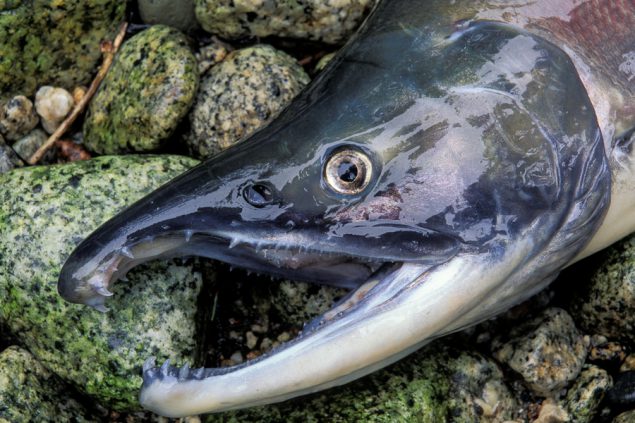
After spawning, the decaying bodies of salmon provide nutrition for entire ecosystems. / Photo by Ian McAllister / Pacific Wild
Watching that heartrending struggle for life, it’s no wonder First Nations people in British Columbia consider salmon not only a vital food source, but also a sacred creature.
Some even believe these fish to be returning relatives. A keystone of Aboriginal culture, salmon figure prominently in legends, art, songs and ceremonies.
Their life cycle has long been well understood. They were always treated with the respect of a fellow being and were harvested sustainably for millennia.
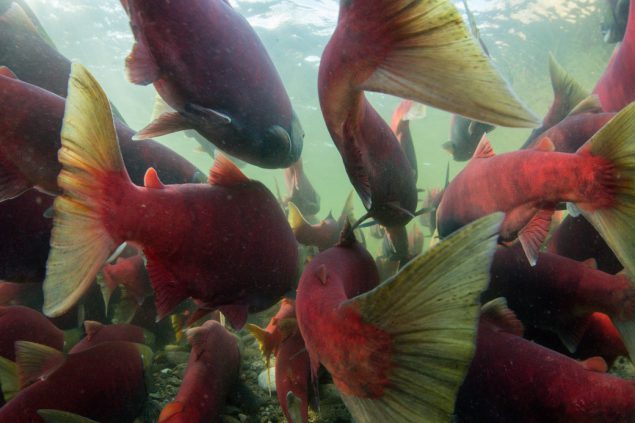
Adams River, B.C. / Photo by Paul Colangelo
The same is true of two other major fish runs in B.C., that of the herring off the West Coast, and that of an amazing little fish up north called the eulachon —a fish that is so oily it can be lit like a candle when dried!
Since Europeans began emptying the seas with little regard for the complex web connecting all creatures that is so integral to First Nations’ survival, the numbers of all these fish have plummeted.
Today, Indigenous people find themselves fighting not only for their own rights, but also for those of the creatures that helped sustain them to this day, since strong connections with traditional foods are not a thing of the past.
For example, it’s been reported that Vancouver Island First Nations eat an average of 60 kilograms of seafood annually, 15 times the Canadian average. Ninety per cent of that seafood is harvested locally, not purchased at grocery stores.
Salmon is B.C.’s iconic fish and there are five species: Chinook, Coho, Chum, Sockeye and Pink. It is the only one of the trio of fish runs found in oceans, rivers and lakes.
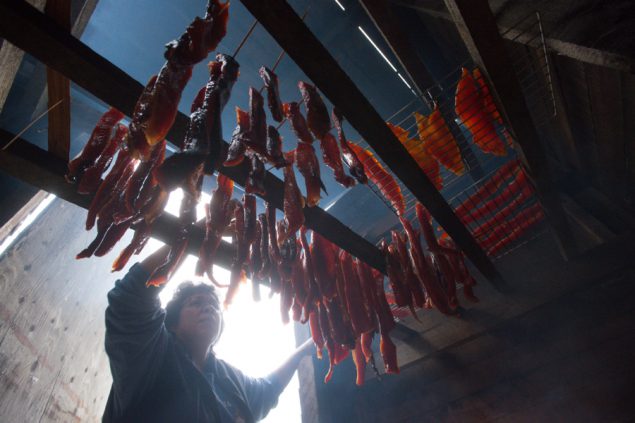
Tina Donald of the Simpcw First Nation smokes sockeye salmon in her backyard smokehouse near Kamloops, B.C. / Photo by Paul Colangelo
The Secwepemc people of the Adams River region fish for salmon about 500 kilometres inland after the fish have migrated up from the coast via the Fraser and Thompson Rivers over the course of about 17 days.
Dried or smoked for winter storage, salmon are so important to the Secwepemc that moons at certain times of the year as well as months are named after them.
“Our word for September means ‘time of salmon.’ That’s when we wait to hear the first crickets before starting to fish,” says Frank Antoine, cultural liaison at Quaaout Lodge on Shuswap Lake. “October means ‘time of spawning’ and the time when we stop fishing to let the stocks build up again. Then we go look for deer.”
Salmon may be ubiquitous, but historically, herring off B.C.’s coast was by far the most abundant fishery — bigger than all the salmon runs combined and an essential link in the marine food chain.
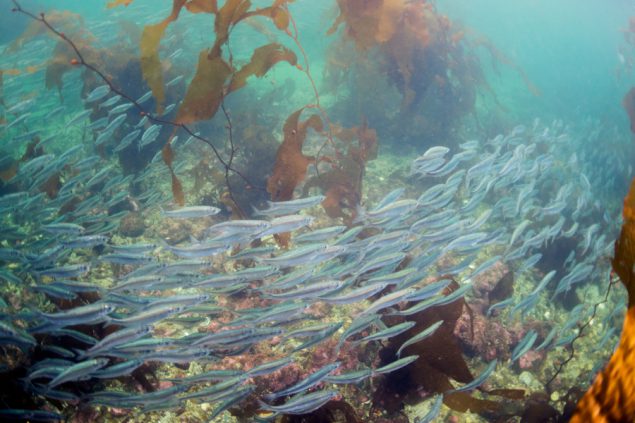
Pacific herring in the Great Bear Sea / Photo by Ian McAllister / Pacific Wild
“They were a staple for us, so plentiful we scooped them up with herring rakes,” says Harvey Humchitt, a hereditary chief of the Heiltsuk Nation in Bella Bella.
From mid-March to late April stretches of shallow waters, kilometres long, become milky white with milt, fish and eggs deposited mostly onto kelp and eel grass.
The skies fill with gulls and the waters teem with seals, sea lions and feeding whales. Even bears along the shorelines enjoy the herring roe-covered kelp and eel grass.
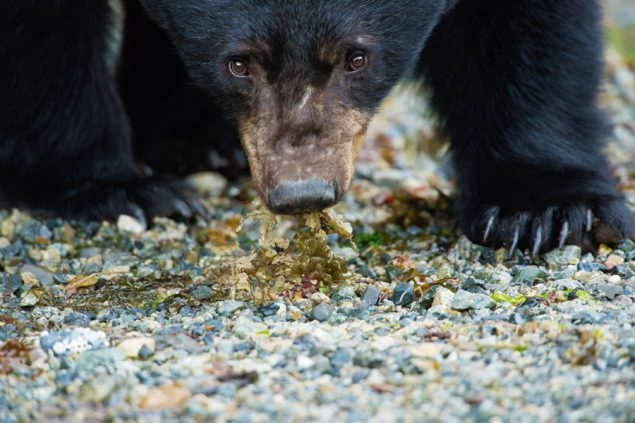
Herring eggs bring large carnivores like this black bear to the shores of the Great Bear Rainforest. / Photo by Ian McAllister / Pacific Wild
“We fasten hemlock boughs upright in the water so they look like waving kelp and the herring lay their eggs on them. Then we peel them off and salt them to preserve them,” says Humchitt. His people also eat spawn-on-kelp, a delicacy in Japan as well, and fresh herring.
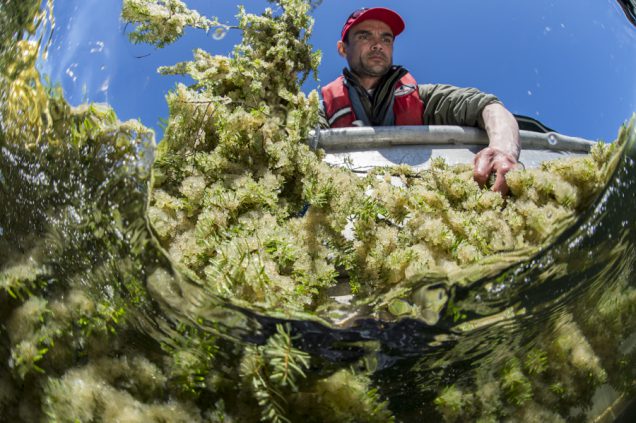
Herring ‘spawn-on-hemlock’ being harvested in Heiltsuk territory by Jordan Wilson/ Photo by Ian McAllister / Pacific Wild
Today, herring are at a fraction of their former numbers. Humchitt says 80 per cent of the spawning areas his people formerly used have vanished because the herring fishery catastrophically collapsed in the 1980s and was shut down.
“They hadn’t opened for very long in the ‘80s, but so many boats were taking massive volumes,” says Hegus (Chief) Clint Williams of the Tla’amin Nation located on the Sunshine Coast.
“At night, there were more lights on the water than in Powell River. They haven’t been able to do traditional herring fishing since then.” The Heiltsuk Nation’s Harry Humchitt agrees: “They took everything.”
After a 30-year moratorium on commercial herring fishing, stocks were finally beginning to show the first weak signs of returning in recent years when the Department of Fisheries and Oceans (DFO) announced it was planning a commercial opening in 2015.
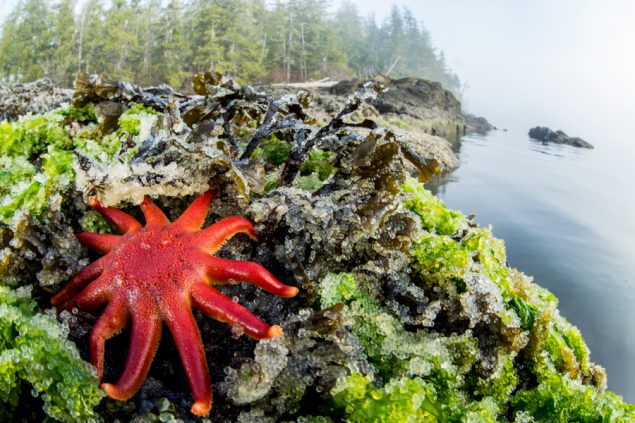
A northern sunstar and freshly laid herring eggs in the Great Bear Rainforest. Photo by Ian McAllister / Pacific Wild.
Alarms went off up and down the coast. The Tla’amin Nation served notice that they would take action to halt any commercial herring roe fishery in their traditional waters.
In March 2016, the Heiltsuk Nation also protested by peacefully occupying the local DFO office for three days. Finally, government policy makers backed down and both groups are now working together on joint management. “It is still too soon,” says Williams (of the Tla’amin Nation).
Though eulachon stocks are down, too, there is no commercial fishery and the fish are predominantly taken in the traditional way by First Nations like Northern B.C’.s Nisga’a, for whom they were historically a survival tool.
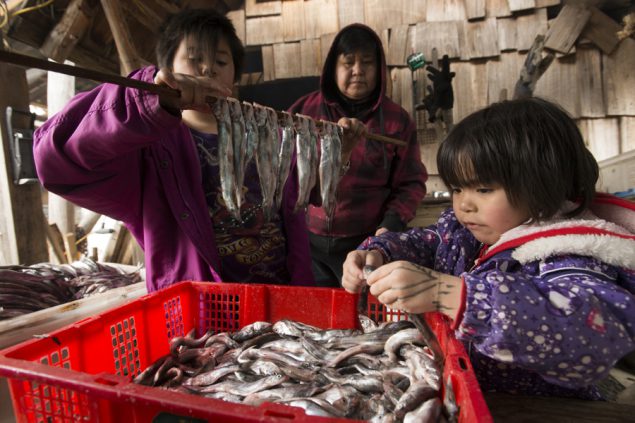
A Nisga’a family strings eulachon onto rods to be hung in their family smokehouse. / Photo by Paul Colangelo
“We called it the ‘saviour’ or ‘salvation’ fish,” says Harry Nyce Sr., director of Nisga’a Fisheries and Wildlife, “because they showed up in late February, often under the river ice, in time to save our people from starvation after a hard winter.”
To this day, before the eulachon run every year, seven family groups — including one calling themselves the Dirty Dozen — set up camps along Fishery Bay on the Nass River, about two hours north of Terrace, to fish for the entire community.
As the waters turn silver with schools of six- to eight inch-long eulachon, the men drive wooden poles into the rushing river bottom to anchor their funnel nets or cut through ice to reach the fish.
For three to four intense, backbreaking weeks, the men work around the clock filling huge wooden bins with fish to ferment and then cook.
Once the bins are full, fishing ceases so that the eulachon can continue on their spawning migration. Each of these seven family groups processes about six tonnes of fish, with women stringing together and drying or smoking many of the whole fish.
The precious golden oil that makes up almost 20 per cent of the smelt-like fish’s body weight is extracted and cooled into tubs of white grease, a delicacy used today as a condiment.
“It’s delicious spread on freshly baked bread,” says Stephanie Halapija, curator and director of the Nisga’a Museum. “I guard my jar with my life!”
The grease was once used for everything from medicine and high-energy food to lighting as eulachon were also called “candlefish.”
As well, it was a valuable trading commodity transported in airtight cedar bentwood boxes on sleds along a vast network of “grease trails” that in the 1700s stretched from the Fraser River to Alaska and even crossed the Northern Rockies. “In some places the routes have been worn down for so many centuries they are a five foot-deep rut,” says Nyce, from Nisga’a Fisheries and Wildlife.
Like many coastal First Nations, the Nisga’a are blessed with their access to salmon, herring and eulachon, the traditional holy trinity of survival.
The Nisga’a people, explains Halapija, are still strongly connected with their land.
“They were never forced off their land as others were, so there is a cultural purity here — with family, with land, with other tribes — that’s wonderful to see. “When they say they’ve been here since time immemorial,” she adds, “they mean it literally.”
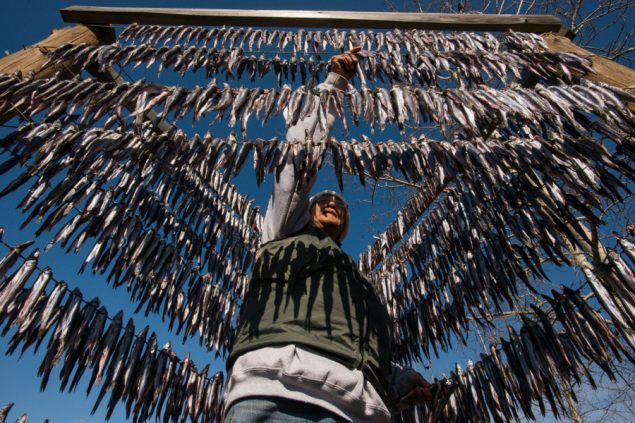
Stacey Gosnell of the Nisga’a First Nation hangs eulachon to dry in the sun. / Photo by Paul Colangelo
The Adams River salmon journey moved me so deeply as a youngster that experiencing the eulachon migration and the ancient — and still very much alive — riverside processing ritual has long been at the very top of my bucket list.
Like salmon or herring runs, it offers a chance to reconnect even the most urban soul with nature’s complex calendar and to witness a traditional way of life that is intimately entwined with the earth and its fellow beings.
Founded by two Canucks on the loose in a big country, Toque & Canoe is a blog about Canadian travel culture.


Linda commented:
Our Scottish Father, William Strachan, would have loved this story by Margo Pfeiff. He was a Fisheries Inspector (in Prince Rupert, B.C. ) in charge of the spawning areas of the lower Skeena River in the 1930’s 40’s and 50’s for approximately 29 years. He was keenly concerned about conservation “always alert to the necessity of ensuring sufficient spawners on the Skeena tributaries – one of his biggest concerns was the nylon net…” He was part of an important herring investigation conducted by the Department of Fisheries. My sister, Margaret and I, grew up hearing names of places like Oona River, the Ecstahl River, Kitwanga, Kitwancool, and Kispiox. The Nass and its eulachons became a permanent part of our memories. This is a wonderful story accompanied by exceptional photographs. Thanks ever so much Margo Pfeiff, Ian McAllister and Paul Coangelo.
Margo Pfeiff commented:
Thanks, Linda. So glad you enjoyed the story. It was a rare treat to be able to become immersed in this fascinating subject and to talk with the people still involved in protecting these ancient traditions. Margo
Lorna Crozier commented:
Thanks, Margo, for this story. I learned so much. And I want to learn more.
Dave commented:
Really enjoyed this article! I come from a fishing family in Nova Scotia where the fishery has also been decimated by overfishing, so I can relate. I must read more articles on this site now…
Margo Pfeiff commented:
Sorry for the delay in thanking you for your comment. I hope you enjoy the other stories on this great site as much.
Pepe commented:
Hi I have read this incredible history from afar, North of Spain, in a time when the new replace the old very fast, for me this article has a enormous value. Don’t let youngest generations not knowing this culture.
toque & canoe commented:
Thank you so much for your comment – all the way from the north of Spain! We agree that we all have so much to learn from older, more sustainable ways. Take care and stay safe!
Margo Pfeiff commented:
It’s always a pleasure to learn good news stories like this are resonating all around the world because these are global issues and we need to work together to preserve our planet. That includes using the knowledge and understanding of indigenous people and inspiring our young people to carry on these traditions that have been successful over thousands of years. Gracias.